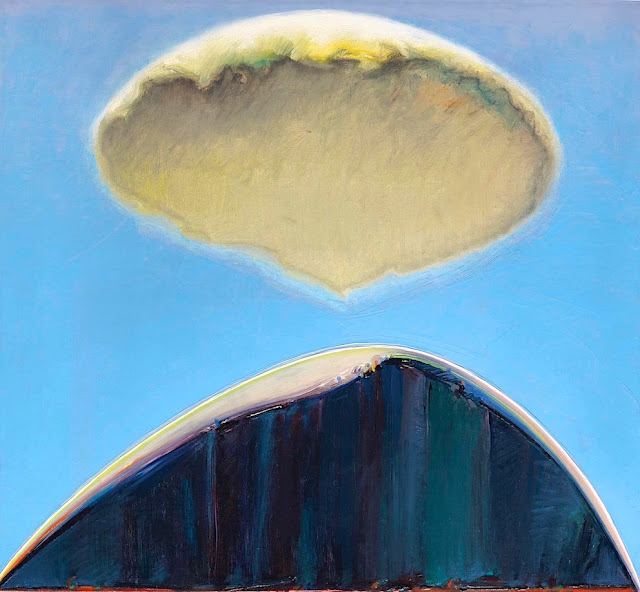DAVID HOCKNEY (bn. 1937)
Middle Cathedral Rock (2,026 m - 6,648 ft)
El Capitan (2,309 m - 7,573 ft)
Sentinel Dome (2,477 m - 8,127 ft)
Half Dome (2, 695 m - 8,844 ft)
United States of America (California)
In Yosemite I, October 16, 2011,
iPad drawing printed on four sheets of paper, mounted on four sheets of Dibond, Private collection
Mountains of Yosemite Valley
The Middle Cathedral Rock (2,026 m- 6,648 ft) (on right in the painting above with the cascades) is a prominent rock face on the south side of Yosemite Valley, California.
El Capitan (2,309m - 7,573 ft) (on left in the painting above) is a vertical rock formation in Yosemite National Park, located on the north side of Yosemite Valley, near its western end. The granite monolith extends about 3,000 feet (900 m) from base to summit along its tallest face and is one of the world's favorite challenges for rock climbers. The formation was named "El Capitan" by the Mariposa Battalion when it explored the valley in 1851. El Capitan ("the captain", "the chief") was taken to be a loose Spanish translation of the local Native American name for the cliff, variously transcribed as "To-to-kon oo-lah" or "To-tock-ah-noo-lah". It is unclear if the Native American name referred to a specific tribal chief or simply meant "the chief" or "rock chief". In modern times, the formation's name is often contracted to "El Cap", especially among rock climbers and BASE jumpers.
Sentinel Dome (2,477m - 8,127ft) (behind Cathedral rock in the painting above) is a granite dome in Yosemite National Park, United States. It lies on the south wall of Yosemite Valley, 0.8 miles (1.3 km) southwest of Glacier Point and 1.4 miles (2.3 km) northeast of Profile Cliff. Sentinel Dome is known for a Jeffrey Pine that grew from its peak (see photograph above). The pine was photographed as early as 1867 by Carleton Watkins, and was the subject of the
well-known photograph by Ansel Adams. The pine died during the drought of 1976, but remained standing until August 2003. The original Native American name of Sentinel Dome, in the Southern Sierra Miwok language, was "Sakkaduch". The Bunnell survey named it "South Dome", but the Whitney survey renamed it Sentinel Dome (from its likeness to a watch-tower). The view from the top offers a 360 degree view of Yosemite Valley and surroundings. One can see
Half Dome,Yosemite Falls,
El Capitan, North Dome, Basket Dome, and much more.
Half Dome (2, 695 m - 8,844 ft) (behind Sentienl Dome in the painting above) is a granite dome at the eastern end of Yosemite Valley in Yosemite National Park, California, part of the Sierra Nevada Range. It is a well-known rock formation in the park, named for its distinct shape; One side is a sheer face while the other three sides are smooth and round, making it appear like a dome cut in half. The impression from the valley floor that this is a round dome that has lost its northwest half is an illusion. From Washburn Point, Half Dome can be seen as a thin ridge of rock, an arête, that is oriented northeast-southwest, with its southeast side almost as steep as its northwest side except for the very top. Although the trend of this ridge, as well as that of Tenaya Canyon, is probably controlled by master joints, 80 percent of the northwest "half" of the original dome may well still be there. As late as the 1870s, Half Dome was described as "
perfectly inaccessible" by Josiah Whitney of the California Geological Survey. The summit was finally conquered by George G. Anderson in October 1875, via a route constructed by drilling and placing iron eyebolts into the smooth granite.
The artist
David Hockney (born 9 July 1937) is an English painter, draughtsman, printmaker, stage designer and photographer. An important contributor to the pop art movement of the 1960s, he is considered one of the most influential British artists of the 20th century.
At the Royal College of Art, Hockney featured in the exhibition Young Contemporaries—alongside Peter Blake—that announced the arrival of British Pop art. He was associated with the movement, but his early works display expressionist elements, similar to some works by Francis Bacon. When the RCA said it would not let him graduate in 1962, Hockney drew the sketch The Diploma in protest. He had refused to write an essay required for the final examination, saying he should be assessed solely on his artworks. Recognising his talent and growing reputation, the RCA changed its regulations and awarded the diploma. After leaving the RCA, he taught at Maidstone College of Art for a short time. A visit to California, where he subsequently lived for many years, inspired him to make a series of paintings of swimming pools in the comparatively new acrylic medium rendered in a highly realistic style using vibrant colours. The artist moved to Los Angeles in 1964, returned to London in 1968, and from 1973 to 1975 lived in Paris.
Hockney has a home and studio in Kensington, London and two residences in California, where he has lived on and off for over 30 years: one in Nichols Canyon, Los Angeles, and an office and archives on Santa Monica Boulevard in West Hollywood, California.
_____________________________
2020 - Wandering Vertexes...
by Francis Rousseau







